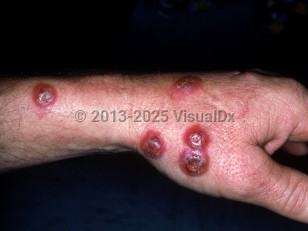Cowpox in Adult
Alerts and Notices
Important News & Links
Synopsis

Cowpox is caused by infection with cowpox virus, a member of the genus Orthopoxvirus in the family Poxviridae. Although originally isolated from cattle, the virus is now most commonly acquired by humans from domestic cats and occasionally rodents. Rodents are the natural reservoirs of the virus, and domestic cats become infected while hunting animals such as voles, wood mice, and rats. While the greatest risk factors are exposure to and trauma from domestic cats (the virus is also known as feline orthopoxvirus), multiple other animal species are implicated in the literature.
The disease usually presents as solitary lesions or multiple localized lesions on the skin 1 week after exposure to an infected animal. The lesions are usually tender. Tender lymphadenopathy near the infected site is common. The lesions progress to necrotic eschars over several weeks and heal with scars in 6-8 weeks, in most cases. The skin lesions can be accompanied by fever and flu-like symptoms. The disease is generally self-limited. Most modern reports of cowpox infection have been from Europe and the western states of the former Soviet Union.
Another member of the genus Orthopoxvirus is vaccinia virus, a virus with no natural host used to vaccinate against smallpox. Based on comparative genetic data, it is theorized that vaccinia virus may be derived from cowpox virus. However, they are distinct species. Eczema vaccinatum, the dissemination of vaccinia after smallpox vaccination, can affect individuals with underlying atopic dermatitis. Cases of disseminated cowpox have been reported in individuals with atopic dermatitis as well, but these are rare.
In June 2013, a novel Orthopoxvirus species was identified in 2 men in the country of Georgia with suspected cowpox infection who had been exposed to ill cows. Zoonotic infections with vaccinia-like viruses have also been reported over the past decade among rural dairy cattle workers in Brazil and buffalo herders in India.
The disease usually presents as solitary lesions or multiple localized lesions on the skin 1 week after exposure to an infected animal. The lesions are usually tender. Tender lymphadenopathy near the infected site is common. The lesions progress to necrotic eschars over several weeks and heal with scars in 6-8 weeks, in most cases. The skin lesions can be accompanied by fever and flu-like symptoms. The disease is generally self-limited. Most modern reports of cowpox infection have been from Europe and the western states of the former Soviet Union.
Another member of the genus Orthopoxvirus is vaccinia virus, a virus with no natural host used to vaccinate against smallpox. Based on comparative genetic data, it is theorized that vaccinia virus may be derived from cowpox virus. However, they are distinct species. Eczema vaccinatum, the dissemination of vaccinia after smallpox vaccination, can affect individuals with underlying atopic dermatitis. Cases of disseminated cowpox have been reported in individuals with atopic dermatitis as well, but these are rare.
In June 2013, a novel Orthopoxvirus species was identified in 2 men in the country of Georgia with suspected cowpox infection who had been exposed to ill cows. Zoonotic infections with vaccinia-like viruses have also been reported over the past decade among rural dairy cattle workers in Brazil and buffalo herders in India.
Codes
ICD10CM:
B08.010 – Cowpox
SNOMEDCT:
70090004 – Cowpox
B08.010 – Cowpox
SNOMEDCT:
70090004 – Cowpox
Look For
Subscription Required
Diagnostic Pearls
Subscription Required
Differential Diagnosis & Pitfalls

To perform a comparison, select diagnoses from the classic differential
Subscription Required
Best Tests
Subscription Required
Management Pearls
Subscription Required
Therapy
Subscription Required
References
Subscription Required
Last Updated:08/13/2017
Cowpox in Adult

